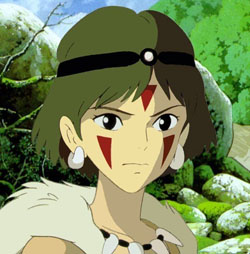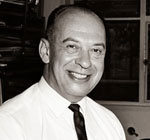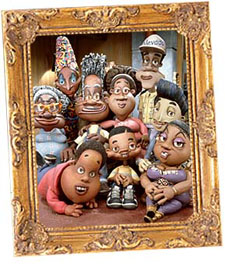 Animated Barbarella. In 1998, Nelvana, the Canadian animation studio was looking to turn the 1968 Jane Fonda live action movie Barbarella based on the Jean-Claude Forest comic story into an animated feature. Then Nelvana considered doing an animated series. “Jean-Claude Forest created a modern-day Candide in Barbarella,” said Michael Hirsh, Co-CEO of NELVANA Limited. “His humor and wit, combined with comedic sexual fantasy, gave birth to our idea of the modern-day heroine.” Forest passed away December 30, 1998.
Animated Barbarella. In 1998, Nelvana, the Canadian animation studio was looking to turn the 1968 Jane Fonda live action movie Barbarella based on the Jean-Claude Forest comic story into an animated feature. Then Nelvana considered doing an animated series. “Jean-Claude Forest created a modern-day Candide in Barbarella,” said Michael Hirsh, Co-CEO of NELVANA Limited. “His humor and wit, combined with comedic sexual fantasy, gave birth to our idea of the modern-day heroine.” Forest passed away December 30, 1998.
Neil Gaiman and Princess Mononoke. Writer Neil Gaiman, famous for his fantasy writing including the DC comic book series Sandman, was approached to write the English language dialog for the Miramax/Disney release of the Miyazaki animated feature Princess Mononoke (1997, U.S. version 1999). Gaiman had seen a few examples of anime but was definitely not an expert. He had been recommended to Miramax president Harvey Weinstein by director Quentin Tarantino whose mother was a fan of Gaiman’s work on short stories and graphic novels.
 Gaiman was particularly interested at first in tackling the assignment but when he was told that Leonardo DiCaprio might do the voice of Ashitaka (eventually voiced by Billy Crudup), he decided to at least view the film because he had a thirteen year old daughter who was a huge DiCaprio fan. At a private screening in Los Angeles, Gaiman fell in love with the film and agreed. He was given a cassette of the film and a translation of the dialogue into English-language sub-titles by Studio Ghibli representative Steve Alpert, who was always available to answer Gaiman’s many questions about the characters and the folklore.
Gaiman was particularly interested at first in tackling the assignment but when he was told that Leonardo DiCaprio might do the voice of Ashitaka (eventually voiced by Billy Crudup), he decided to at least view the film because he had a thirteen year old daughter who was a huge DiCaprio fan. At a private screening in Los Angeles, Gaiman fell in love with the film and agreed. He was given a cassette of the film and a translation of the dialogue into English-language sub-titles by Studio Ghibli representative Steve Alpert, who was always available to answer Gaiman’s many questions about the characters and the folklore.
“Basically I sat there and wrote with the video on,” said Gaiman. “The main trick was trying to turn this all into words that people could say. Sub-titles aren’t necessarily either meant to match with the mouth movements or sound like natural dialog. My job was to turn it into something that somebody can say without sounding stupid. I had Miramax on one side wanting one thing and Studio Ghibli on the other side wanting another thing. Miramax would go, ‘Don’t say kimono, say robe. Don’t say samurai, say warrior.’ Miramax wanted to reach the widest possible audience. I wound up filled with admiration for professional translators.”
 Praise for Marc Davis. Award winning animator Bob Kurtz was a student of Disney Legend Marc Davis when he taught at the Chouinard Art Institute in Los Angeles. In a 1999 interview, Kurtz remembered: “One of the things he did in class was that he would make us draw the models in thirty second or one minute poses. You would do some sketches, March would say, ‘Time’, the model would change pose and all the other students would moan. But I loved it! He was showing us that you have to be focused and use your intuition. Animators get cast like actors. There are certain roles you wouldn’t put them in. But it’s difficult to think of a role Marc couldn’t handle. To use a baseball analogy, he’s not just the team’s utility players, he’s the pitcher, the batter and the fielder all in one.”
Praise for Marc Davis. Award winning animator Bob Kurtz was a student of Disney Legend Marc Davis when he taught at the Chouinard Art Institute in Los Angeles. In a 1999 interview, Kurtz remembered: “One of the things he did in class was that he would make us draw the models in thirty second or one minute poses. You would do some sketches, March would say, ‘Time’, the model would change pose and all the other students would moan. But I loved it! He was showing us that you have to be focused and use your intuition. Animators get cast like actors. There are certain roles you wouldn’t put them in. But it’s difficult to think of a role Marc couldn’t handle. To use a baseball analogy, he’s not just the team’s utility players, he’s the pitcher, the batter and the fielder all in one.”
Do You Want to Shaggy Now or Later? In 1998, it was announced that New Line was developing an animated television series based on the Austin Powers movies with creator and star Mike Myers providing the voice. That same year, Myers bought the rights to do a live action version of Scooby-Doo, Where Are You? Myers was writing the script and intended to portray the character of Shaggy.
 The Birth of the PJs. Comedian Eddie Murphy happened to watch an episode of the British television sci-fi 1960s series The Thunderbirds and thought he might be able to do extreme behavior in a series done with puppets. His original concept was based on the characters of Punch and Judy, a quarreling married couple living in a housing project. So the idea was referred to as “The PJs”.
The Birth of the PJs. Comedian Eddie Murphy happened to watch an episode of the British television sci-fi 1960s series The Thunderbirds and thought he might be able to do extreme behavior in a series done with puppets. His original concept was based on the characters of Punch and Judy, a quarreling married couple living in a housing project. So the idea was referred to as “The PJs”.
Later the idea evolved into the Will Vinton claymation process and the title was kept but now referred to “the projects”. Murphy mentioned the idea to producer Brian Grazer at Imagine Films who mentioned it to director Ron Howard who was eager to explore the idea. Producers Steve Tompkins and Larry Wilmore were brought in to help define the project.
The series ran for three seasons, forty-three episodes and won three Emmy awards and one Annie award. The show centered on a gruff but sensitive superintendent (or just “super”) of the Lawrence Hilton-Jacobs projects, Thurgood Stubbs (voiced by Murphy). For various reasons, Mark Moseley and Phil Morris filled in voicing the character of Stubbs in some episodes. The characters on the show were not made of the traditional plasticine clay but pliable foam latex, spawning the short-lived term “formation”.
Secrets of Animated People. Arthur Nadel, the head writer and Vice President of Filmation, directed Elvis Presley’s last movie Clambake in 1968. Chico Marx (of the Marx Brothers) had a daughter named Maxine who was once married to animator Shamus Culhane. Filmation director Ed Friedman was a reserve Olympian for the Los Angeles Games of 1932 (which helped bring stardom to participating swimmers Buster Crabbe and Johnny Weissmuller).
Volswagens of Water. For the climax of A Bug’s Life (1998), director John Lasseter wanted to have a chase through a rainstorm which he envisioned as a massive threat to insects. “It’s what I like to call Volkswagens of water landing near you,” stated Lasseter in 1999. “So when the rain comes at the climax of the film, it’s spectacular.”
“John wanted this very physical look to the rain,” explained Adam Woodbury, the effects technical director for the film. “where the volume of water didn’t change over the course of animation, so it really looked like a physical event happening. They had to be like explosions. At one meeting John and (co-director) Andrew Stanton said to watch Gallipolli and look at war movies with mortar fire coming in. So it’s not so much like a water drop, because we added all this energy to the drops, to make them have a big impact. The audience won’t see those things, but they’ll feel them. For every splat of rain, there’s four or five ants that get thrown out. If the shot was held long enough, you’d even see them getting up and shaking themselves off.”



 Jim Korkis is an internationally respected animation historian who in recent years has devoted his attention to the many worlds of Disney. He was a columnist for a variety of animation magazines. With his former writing partner, John Cawley, he authored several animation related books including The Encyclopedia of Cartoon Superstars, How to Create Animation, Cartoon Confidential and Get Animated’s Animation Art Buyer’s Guide. He taught animation classes at the Disney Institute in Florida as well as instructing classes on acting and animation history for Disney Feature Animation: Florida.
Jim Korkis is an internationally respected animation historian who in recent years has devoted his attention to the many worlds of Disney. He was a columnist for a variety of animation magazines. With his former writing partner, John Cawley, he authored several animation related books including The Encyclopedia of Cartoon Superstars, How to Create Animation, Cartoon Confidential and Get Animated’s Animation Art Buyer’s Guide. He taught animation classes at the Disney Institute in Florida as well as instructing classes on acting and animation history for Disney Feature Animation: Florida.




















































Notice no comments this time around. The only thing that came to my head is thinking Nelvana has had the rights to an early Canadian comic book heroine (and one of the first in that field) they’ve acquired some 40 years ago that has never been developed into a animated project of sorts, though I suppose it was optioned once or twice. That of course is the namesake of their studio, “Nelvana of the Northern Lights” by Adrian Dingle. I see though a Kickstarter project was funded last year and there’s going to be a restoration of the original comics of that series that’s in the works, so it’s nice to see some people never forget.
https://www.kickstarter.com/projects/hopelnicholson/nelvana-of-the-northern-lights-canadas-first-super
My goodness! You pack a lot into a single post!